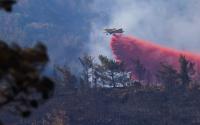5 May 2009by Declan Butlerwww.nature.com/news/2009/090505/full/459014a.html
The World Health Organization (WHO) this week remained on the verge of declaring a pandemic of the H1N1 swine-associated flu virus. Public-health bodies and scientists have made progress in starting to understand the outbreak, but major questions remain about how severe the disease will get.
As Nature went to press, the virus (see 'The turbulent history of the A(H1N1) virus') had extended its range to 21 countries on 5 continents, with 1,124 confirmed cases and 26 deaths. The WHO remained at pandemic alert phase 5 on a scale of 6, having moved up from 3 and then 4 following sustained human-to-human transmission in the Americas.
"We're well past the containment phase," says Ira Longini, an epidemiologist at the University of Washington School of Public Health in Seattle. "We are now in the mitigation phase."
The main challenge for scientists now is assessing how severe any pandemic might be. That's because the WHO's pandemic phases refer only to geographical spread of a new disease; government pandemic plans look more to the outbreak's severity to guide their response. The United States, for example, has very different response plans depending on where a pandemic falls on its hurricane-like scale of severity, ranging from Category 1 (denoting case-fatality rates of less than 0.1%) to 5 (denoting case-fatality rates of 2% or above).
Most cases detected so far have been mild, with relatively few deaths for the number of cases observed. But reliable data are still lacking in Mexico, where most cases have occurred, and the number of cases in other countries remains too small statistically to detect levels of even 1–2% mortality rates, lower than the the 1918 H1N1 influenza pandemic.
Researchers are, however, starting to work up early numbers for some other key variables of spread, including the basic reproductive rate, R0, which is the number of new cases that an infected individual will give rise to. Longini's rough preliminary estimates from field data such as a school outbreak in New York, for instance, suggest that the current R0 is about 1.4. "At this point the virus does not seem as transmissible as past pandemic strains," he says. The R0 of the 1918 pandemic has been estimated at less than four; that of seasonal influenza typically ranges from 1.5 to 3.
Longini also suggests that the generation time — the time period before an infected individual begins infecting others — is probably between 3 and 5 days, but closer to 3. The higher the R0, and the shorter the generation time, the faster and more difficult the spread is to control.
A related way of looking at the virus is the secondary-attack rate, which can be estimated from field data by looking at what proportion of a relatively confined cohort such as a household or school falls ill after exposure to a contact. The current secondary-attack rate is around 25–30%, according to Anne Schuchat of the US Centers for Disease Control and Prevention (CDC) in Atlanta, Georgia. But this number, too, could change.
Click for larger image.Click for larger image.Gavin Smith
Just two weeks into the outbreak, researchers are using the incoming data on transmissibility and infectivity to model scenarios of how the virus might evolve, and to refine and target mitigation-control measures for varying levels of virulence, says epidemiologist Marc Lipsitch of the Harvard School of Public Health.
"My own personal view is that it is too early to say what the severity is," says Lipsitch, who works with the CDC as part of a 'Team B' made up of academic researchers and other outside advisers. One reason the disease appears mild is that in the United States there has been only one reported death among 286 cases. But such case-fatality rates, reported one week after a case is confirmed, can underestimate actual mortality rates, because they can overlook patients who remain ill and subsequently die. This was demonstrated in 2003, when the reported case-fatality rate of severe acute respiratory syndrome (SARS) in Asia was initially put at a few per cent — only to be found to be closer to 20% in studies that followed up cases.
Experts also remember that the 1918 pandemic began with a wave of mild disease in early 1918, only to return with a vengeance at the end of the year. "I'm particularly concerned about what will happen in the fall," Schuchat told reporters on 3 May.
Continually estimating mortality rates is now the top priority of public-health bodies and scientists, and the task should become easier as the number of cases grows.
"The uncertainty is a major challenge. We don't predict influenza very well," says Stephen Morse, an epidemiologist at Columbia University in New York City. "Increased virulence — seeing a number of more serious cases — especially in healthy young adults, would be a trigger for a greatly increased response." As of 4 May, 62% of cases in the United States were in people under the age of 18.
In Mexico, authorities said on 4 May that they would lower the alert level and begin lifting some restrictions on public gatherings, including the shuttering of restaurants. Longini describes the country's actions as appropriate to stemming the spread of a new disease. "Mexico has done a great job of taking the necessary social distancing and containment methods needed to help dampen transmission," he says. Mitigation measures are also intended to minimize social disruption and maximize availability of medical care — by trying to avoid everyone being off sick from work, or overwhelming hospitals, at the same time.
Crucially, they also can buy time until vaccine production can be ramped up. The WHO is looking at how a vaccine for the currently circulating H1N1 strain could be produced, including possibly curtailing the production run for the upcoming seasonal influenza vaccine in order to ramp up production on a vaccine for the new strain. The earliest an H1N1 vaccine could be made would be in four to six months.
For now, the disease is treatable with the drugs zanamivir (Relenza) and oseltamivir (Tamiflu).






